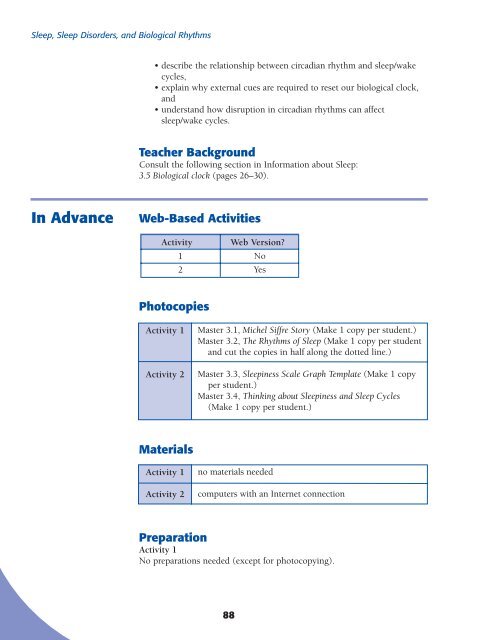Biological - NIH Office of Science Education - National Institutes of ...
Biological - NIH Office of Science Education - National Institutes of ...
Biological - NIH Office of Science Education - National Institutes of ...
Create successful ePaper yourself
Turn your PDF publications into a flip-book with our unique Google optimized e-Paper software.
Sleep, Sleep Disorders, and <strong>Biological</strong> Rhythms<br />
• describe the relationship between circadian rhythm and sleep/wake<br />
cycles,<br />
• explain why external cues are required to reset our biological clock,<br />
and<br />
• understand how disruption in circadian rhythms can affect<br />
sleep/wake cycles.<br />
Teacher Background<br />
Consult the following section in Information about Sleep:<br />
3.5 <strong>Biological</strong> clock (pages 26–30).<br />
In Advance<br />
Web-Based Activities<br />
Activity<br />
1<br />
2<br />
Web Version?<br />
No<br />
Yes<br />
Photocopies<br />
Activity 1<br />
Activity 2<br />
Master 3.1, Michel Siffre Story (Make 1 copy per student.)<br />
Master 3.2, The Rhythms <strong>of</strong> Sleep (Make 1 copy per student<br />
and cut the copies in half along the dotted line.)<br />
Master 3.3, Sleepiness Scale Graph Template (Make 1 copy<br />
per student.)<br />
Master 3.4, Thinking about Sleepiness and Sleep Cycles<br />
(Make 1 copy per student.)<br />
Materials<br />
Activity 1<br />
Activity 2<br />
no materials needed<br />
computers with an Internet connection<br />
Preparation<br />
Activity 1<br />
No preparations needed (except for photocopying).<br />
88

















